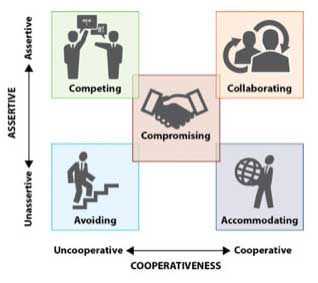Date. 8th November 2022
Conflict resolution: People deal with conflict in a variety of ways, therefore, you need different conflict resolution strategies.
Conflict resolution can be achieved through active listening and training people to resolve conflict using a variety of strategies. This is how the Thomas-Kilmann measurement instrument and their five conflict resolution strategies came to our attention.
Kenneth Thomas and Ralph Kilmann developed five conflict resolution strategies that people use to handle conflict, including avoiding, defeating, compromising, accommodating, and collaborating.
This is based on the assumption that people choose how cooperative and how assertive to be in a conflict. It suggests that everyone has preferred ways of responding to conflict, but most of us use all methods under various circumstances. It is helpful to understand the five methods, particularly when you want to move a group forward.
Avoiding: To avoid is when people just ignore or withdraw from the conflict. They choose this method when the discomfort of confrontation exceeds the potential reward of resolution of the conflict. While this might seem easy to accommodate for the facilitator, people aren’t really contributing anything of value to the conversation and may be withholding worthwhile ideas. When conflict is avoided, nothing is resolved.
Competing: Competing is used by people who go into a conflict planning to win. They’re assertive and not cooperative. This method is characterized by the assumption that one side wins and everyone else loses. It doesn’t allow room for diverse perspectives into a well-informed total picture. Competing might work in sports or war, but it’s rarely a good strategy for group problem solving.
How conflict can lead to revolution failure. It’s what can happen when people feel like they aren’t being listened to and start being assertive.
Accommodating: Accommodating is a strategy where one party gives in to the wishes or demands of another. They’re being cooperative but not assertive. This may appear to be a gracious way to give in when one figures out s/he has been wrong about an argument. It’s less helpful when one party accommodates another merely to preserve harmony or to avoid disruption. Like avoidance, it can result in unresolved issues. Too much accommodation can result in groups where the most assertive parties commandeer the process and take control of most conversations.
Collaborating: Collaborating is the method used when people are both assertive and cooperative. A group may learn to allow each participant to make a contribution with the possibility of co-creating a shared solution that everyone can support.
A great way to collaborate and overcome conflict is to reach out and touch them.
Compromising: Another strategy is compromising, where participants are partially assertive and cooperative. The concept is that everyone gives up a little bit of what they want, and no one gets everything they want. The perception of the best outcome when working by compromise is that which splits the difference. Compromise is perceived as being fair, even if no one is particularly happy.
Workplaces today often involve varying levels of interpersonal and institutional conflict and so much energy is devoted to prevention and management it is understandably difficult to understand how conflict could possibly have a positive side.
It helps to remember that conflict including disagreement, difference of opinion, concern, complaint, friction, etc. is not inherently good or bad. It is an inevitable result of human beings associating with each other in the world, in our families and in our workplaces. There are many books, articles and blog posts trumpeting the benefits of conflict but, on reflection, this phrase is much too simplistic. It is not the conflict that directly creates benefits, it is dealing with the conflict well. The key to unlocking the benefits of conflict is learning to engage effectively with conflict when it arises.
I have red much about conflict and conflict engagement from Bernie Mayer. In his Queen’s IRC article The Paradox of Leadership. Cooperating to Compete, Following to Lead.He emphasizes that how we set the stage for the effective use of conflict and how we respond to conflict is critical to our effectiveness as leaders. This is a leadership competency and these skills are becoming more and more in demand. We can’t deny, avoid or prevent all conflict. So, what can we, as leaders, do? Bernie suggests what to some may be a revolutionary concept.
The more important challenge is to create the space for conflict to occur in a constructive way for people to raise difficult and contentious issues, and for leaders to be exposed to often uncomfortable disagreements. Otherwise, problems fester, important views are squelched and effective communication is inhibited.
So, there are good reasons,try not to allow conflict to fester, but what are the potential positive benefits that could flow from providing such a safe space for conflict to not occur, an effective plan should always be in place to monitor any conflicts.


PGDCM PGDSM PGCPM MQSI SACD
Construction- Quantity Surveyor- Valuer/ Appraiser. Project Management
37 PattensenTurkeyen, Dennis Street, Georgetown, Guyana
Email. Jewelccameron55@yahoo.com